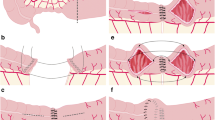Abstract
In spite of modern suture materials and different techniques in colonic anastomoses after resection, leakage is still the most feared complication in colonic surgery. In female pigs of Swedish land breed, standardized 5-cm long colonic resection was performed 10 cm above the peritoneal deflection, usign either a single layer of Gambee-stitches (n=6, Vicryl® 4-0), two-layer interrupted stitches (n=6, Vicryl® 4-0) or the intraluminal stapling device (n=6, ILS Ethicon®). After one week, the animals were sacrificed and an anastomotic index was calculated usingin vitro x-ray. Also, anastomotic circulation (calculated by the microsphere technique), breaking strength, and histologic evaluation were performed. All animals survived and no leakage was observed. The time to perform, the anastomosis was significantly shorter (P<0.05) for the stapling device compared with the manual techniques used. The anastomotic index was lower (P<0.05) for two rows (0.24) compared with Gambee-stitches (0.38) or stapler anastomoses (0.37). There were no differences in blood flow among the three groups and no differences in breaking strength. Macroscopic investigation revealed mucosal defects in two of the stapled anastomoses and histologic investigation showed small areas of necrosis. The stapling device did not induce any inflammatory reaction. On the other hand, a severe inflammatory reaction was seen when using conventional suture materials. In conclusion, this study shows that a single row of Gambee-stitches is equal to the ILS stapling device when performing colonic anastomoses and these two methods seem to be superior to the two-layer technique.
Similar content being viewed by others
References
Goligher JC, Lee PWG, Simpkins KC, Lintott DJ. A controlled comparison of one- and two-layer techniques of suture for high and low colorectal anastomoses. Br J Surg 1977;64:609–14.
Everett WG. A comparison of one-layer and two-layer techniques for colorectal anastomoses. Br J Surg 1975;62:135–40.
Gambee LP. A single-layer open intestinal anastomoses applicable to the small as well as the large intestine. W J Surg Obstet Gynecol 1951;59:1–5.
Blamey SL, Lee PWR. A comparison of circular stapling devices in colorectal anastomoses. Br J Surg 1982;69:19–22.
Brennan SS, Pickford IR, Evans M, Pollock AV. Staples or sutures for colonic anastomoses—a controlled clinical trial. Br J Surg 1982;69:722–4.
Beart RW, Kelly KA. Randomized prospective evaluation of the EEA stapler for colorectal anastomoses. Am J Surg 1981;141:143–6.
Bubrick MP, Rolfsmeyer ES, Schauer RM, et al. Effects of high-dose and low-dose preoperative irradiation on low anterior anastomoses in dogs. Dis Colon Rectum 1982;25:406–15.
Bubrick MP, Lundeen JW, Hitchcock CR. A comparative radiographic study of low anterior colon anastomoses in dogs. Surgery 1978;89:454–9.
Keane FB, Moore DJ, Byrne PJ, Hennessy TP. A comparison of circular stapling devices for rectal anastomoses: a study in dogs. Dis Colon Rectum 1982;25:285–8.
Polglase AL, Hughes ESR, McDermott FT, Burke FR. A comparison of end-to-end staple and suture colorectal anastomoses in the dog. Surg Gynecol Obstet 1981;152:792–6.
Sundqvist K, Hafström L-O, Persson B. Measurements of total and regional tumor blood flow and organ blood flow using99Tcm-labelled microspheres: an experimental study in rats. Eur Surg Res 1978;10:433–43.
Löwenhielm P. Dynamic strain tolerance of blood vessels at different post mortem conditions. J Bioengineering 1978;2:509–15.
Fasth S, Hedlund H, Svaninger G, Hultén L. Autosuture of low colorectal anastomosis. Acta Chir Scand 1982;148:535–9.
Heald RJ, Leicester RJ. The low stapled anastomosis. Br J Surg 1981;68:333–7.
Jiborn H, Ahonen J, Zederfeldt B. Healing of experimental colonic anastomoses. Am J Surg 1978;136:587–94.
Author information
Authors and Affiliations
Additional information
Grant support from the Segerfalk Foundation.
About this article
Cite this article
Graffner, H., Andersson, L., Löwenhielm, P. et al. The healing process of anastomoses of the colon. Dis Colon Rectum 27, 767–771 (1984). https://doi.org/10.1007/BF02553934
Received:
Issue Date:
DOI: https://doi.org/10.1007/BF02553934




